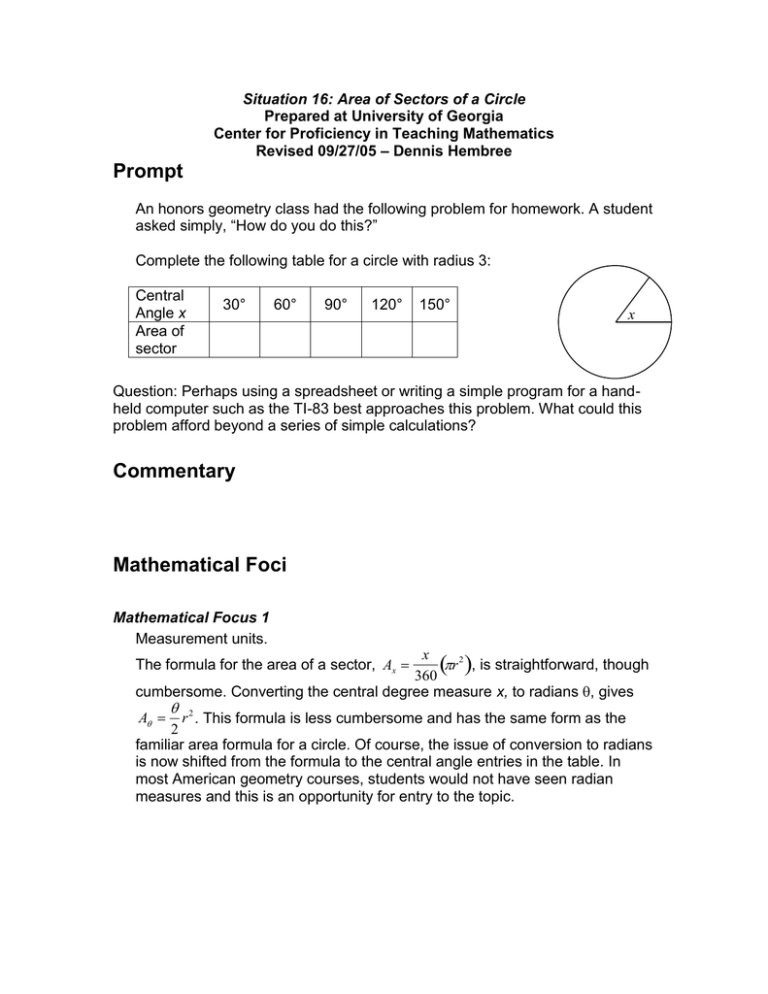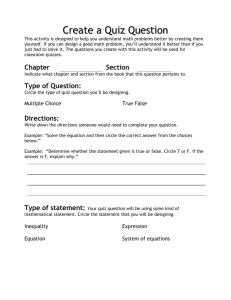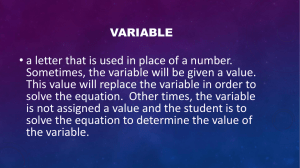Situation 16: Area of Sectors of a Circle – Dennis Hembree
advertisement

Situation 16: Area of Sectors of a Circle Prepared at University of Georgia Center for Proficiency in Teaching Mathematics Revised 09/27/05 – Dennis Hembree Prompt An honors geometry class had the following problem for homework. A student asked simply, “How do you do this?” Complete the following table for a circle with radius 3: Central Angle x Area of sector 30° 60° 90° 120° 150° x Question: Perhaps using a spreadsheet or writing a simple program for a handheld computer such as the TI-83 best approaches this problem. What could this problem afford beyond a series of simple calculations? Commentary Mathematical Foci Mathematical Focus 1 Measurement units. x r 2 , is straightforward, though 360 cumbersome. Converting the central degree measure x, to radians , gives The formula for the area of a sector, Ax A r 2 . This formula is less cumbersome and has the same form as the 2 familiar area formula for a circle. Of course, the issue of conversion to radians is now shifted from the formula to the central angle entries in the table. In most American geometry courses, students would not have seen radian measures and this is an opportunity for entry to the topic. Mathematical Focus 2 Function. Plotting the points (x, Ax ) on the Cartesian plane suggests questions about continuity, domain and range, and other analyses of the resulting graphical situation. For this particular problem with r 3 , we are plotting the continuous linear function Ax 40 x with domain 0 x 360 . Plotting the calculated, rounded values is unlikely to produce a regression line with the exact slope and a y-intercept of zero. Mathematical Focus 3 Similarity. It may be surprising that a linear change in one measurement of an object does not produce a quadratic change in the area of the object. Such a statement about quadratic change refers to comparing similar figures. This problem situation does not compare similar figures, but rather investigates fractional portions of a given, fixed x B A figure, much like asking for the area of the shaded portion of this square as x increases along side AB. Mathematical Focus 4 Algebraic representation. What are appropriate algebraic representations for the area function in this problem? The answer depends on the use of the representation. The x is the cleanest of the representations in that it is in a simplified form Ax 40 x 32 familiar form for a linear equation. The more complex form Ax 360 retains the structure of the problem setting. A calculated, approximate such as equation Ax .0785x is a user- and calculation-friendly representation. The value for use of each of these representations depends on the context of the problem and intent of the user/teacher.



